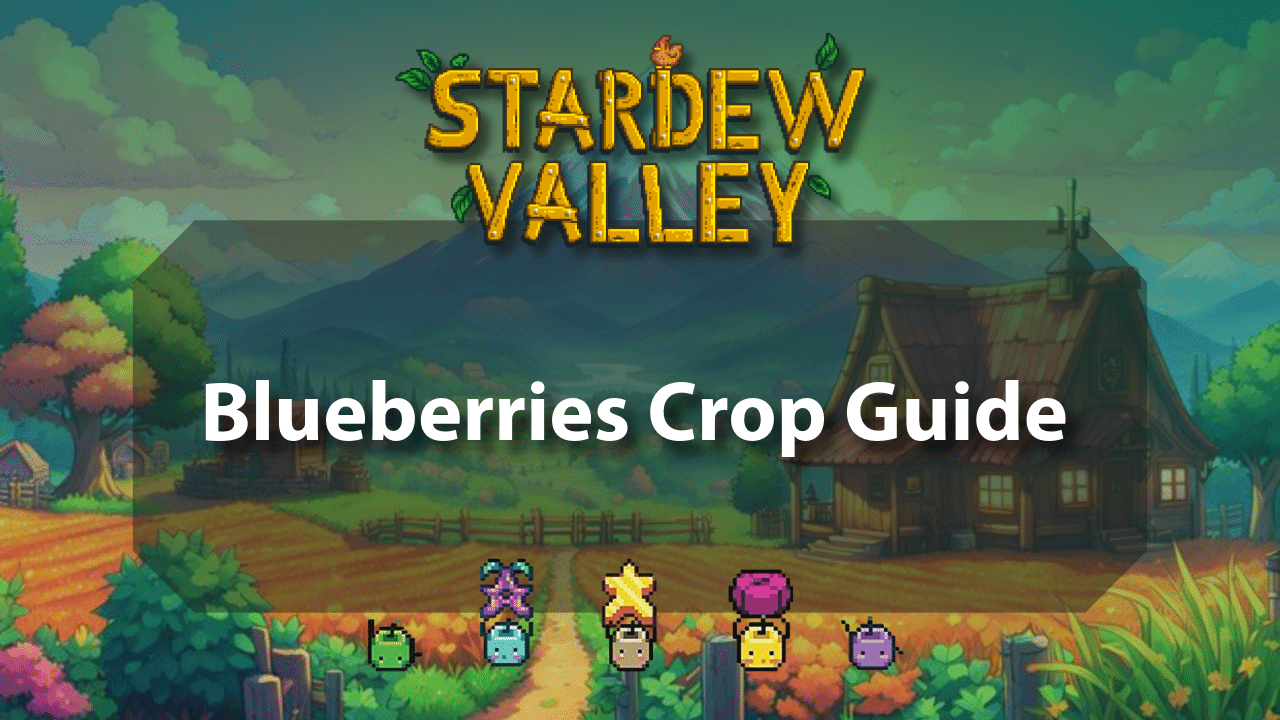Stardew Valley Blueberries Crop Guide - Theria Games

Introduction
The Stardew Valley Blueberries Crop Guide will help you maximize your farm’s potential by focusing on one of the most profitable summer crops available. Blueberries take 13 days to fully mature, but once they reach this stage, they continuously produce fruit every four days without requiring replanting. Each plant yields three blueberries per harvest, with a chance for additional berries, making them an excellent source of steady income throughout the season. Due to their high yield and regrowth cycle, blueberries are a great option for farmers who want to minimize effort while maintaining a consistent cash flow.
To get the most out of your blueberry harvest, it is best to plant them in large quantities as early in the summer as possible. Using quality sprinklers ensures that watering is automated, saving time and energy that can be used for other farm activities. Fertilizers like Speed-Gro can help blueberries grow faster, but since they are a multi-harvest crop, the benefits are limited compared to single-harvest plants. However, using basic or quality fertilizer can increase the chance of harvesting higher-quality blueberries, leading to better profits.
While selling raw blueberries is already profitable, processing them into artisan goods significantly increases their value. Turning blueberries into wine using kegs or making jelly in preserves jars can more than double the selling price, making them one of the best crops for long-term financial gain. If you choose the Tiller profession, which boosts crop sell prices by 10%, your profits will be even greater. When combined with the Artisan profession, which increases the price of artisan goods, blueberry wine becomes one of the most lucrative products in the game.
Since blueberries continue producing without the need for replanting, they are one of the most efficient and low-maintenance crops in Stardew Valley. They require an initial investment in seeds and setup but quickly become a reliable source of income. Whether you are a beginner looking for a simple yet effective way to make gold or an experienced farmer optimizing your fields for maximum profit, blueberries are an excellent addition to any farm.
Why Choose Blueberries?
Blueberries are a fantastic crop choice in Stardew Valley due to their high yield, steady income potential, and multiple uses. They are a multi-harvest crop, meaning that after an initial growth period of 13 days, they will continue to produce fruit every four days without needing to be replanted. Each harvest yields three blueberries per plant, with a small chance of additional berries, making them one of the most consistent sources of income throughout the summer.
With a base selling price of 50 gold per blueberry, they offer reliable earnings, especially when grown in large quantities. Choosing the Tiller profession increases their value by 10%, while silver and gold quality blueberries fetch even higher prices. Processing blueberries into jelly or wine greatly enhances their profitability. Blueberry wine, in particular, sells for a much higher price than raw fruit, and with the Artisan profession, its value increases even further. This makes blueberries an excellent crop for players looking to maximize profits from artisan goods.
Beyond selling, blueberries have several additional uses. They can be used in cooking recipes like Blueberry Tart and Fruit Salad, both of which provide energy and health boosts. They are also used in tailoring, where they create dyeable shorts and serve as a blue dye at the dye pots. In terms of gifting, several villagers like or love blueberries, making them a useful crop for building friendships.
Compared to other crops, blueberries stand out for their high yield and consistent returns. While strawberries have a higher base selling price, blueberries are more accessible and continue to produce throughout the summer. Cranberries, another multi-harvest crop, offer strong profits in the fall, but blueberries provide more fruit per plant over the course of a season, making them a great choice for mass production. Ancient fruit is the most profitable crop in Stardew Valley, but it only produces one fruit per week, whereas blueberries provide frequent and abundant harvests.
Overall, blueberries are an excellent summer crop due to their steady yield, strong profit potential, and versatility. Whether sold raw, processed into artisan goods, or used in recipes and gifts, they are a valuable addition to any farm and a dependable choice for maximizing income.
Getting Started
To begin your journey into blueberry farming in Stardew Valley, it’s important to understand how to acquire seeds, the best time to plant them, and how long they take to grow and produce fruit. Blueberry seeds can be purchased from Pierre’s General Store for 80 gold each, making them easily accessible at the start of summer. They are also available at the Magic Shop Boat during the Night Market on Winter 16 for the same price.
Occasionally, the Traveling Cart may sell them, though at a higher price of 120 gold. Other ways to obtain blueberry seeds include using the Seed Maker, finding them in treasure rooms within Skull Cavern, or growing them from Mixed Seeds on Ginger Island. However, they are not sold at JojaMart, so players following the Joja route will need to find alternative sources.
Blueberries can only be planted during the summer, as they will not grow in spring or fall unless grown in the greenhouse or on Ginger Island. To maximize harvests, it is best to plant them as early in the season as possible. The plants take 13 days to mature, and after their first harvest, they will continue producing blueberries every four days without needing to be replanted. This makes them a great crop for consistent income throughout the season.
Before planting, it’s important to prepare the soil by clearing weeds, rocks, and debris from the area. Using a hoe to till the soil will make it ready for planting, and applying fertilizer can improve the quality of the harvested blueberries. Speed-Gro can slightly shorten the growth time, but since blueberries continuously produce after maturing, its long-term benefits are limited. Setting up sprinklers can also be helpful, as they automate watering and reduce daily maintenance.
By understanding the process of acquiring, planting, and caring for blueberries, players can take full advantage of this profitable crop and ensure a steady income throughout the summer season.
Growing Blueberries
Once you have your blueberry seeds and the soil is prepared, it’s time to plant and care for your crop to ensure a successful harvest. After tilling the soil, place the blueberry seeds into the ground and make sure to plant them during the summer, as this is the only season they will grow unless using a greenhouse or planting on Ginger Island. To maximize your overall yield, it is best to plant them as early in the season as possible.
Watering the seeds daily is essential for proper growth. Missing a day of watering will delay their progress, so setting up a sprinkler system can be a great way to automate the process and save time. Once planted, blueberries take 13 days to reach maturity, at which point they will begin producing fruit every four days. Since they are a multi-harvest crop, blueberries will continue to provide income without needing to be replanted, making them one of the most efficient crops in the game.
Using fertilizer can improve the quality of the harvest or speed up the growth process. Speed-Gro is a useful option, as it reduces the initial growth time by one day, allowing the first harvest to occur on Summer 12 instead of Summer 13, which results in one additional harvest before the season ends. Basic and Quality Fertilizer can also be used to improve the quality of the first blueberry harvested from each plant, though the other two will always remain regular quality.
To protect the crop, placing scarecrows nearby will prevent crows from eating the plants. Scarecrows cover a specific area, so it is important to position them effectively to protect as many crops as possible. Since blueberries grow in bushes rather than trellises, players can walk through them, making harvesting easier even when planted in large quantities.
By following these steps, you can ensure a healthy and productive blueberry farm, taking full advantage of this profitable summer crop to generate steady income throughout the season.
Harvesting Blueberries
After patiently tending to your blueberry crop, the time will come to gather your harvest. Blueberries are ready to be picked when they turn a deep blue color, signaling they have fully ripened. The first harvest occurs 13 days after planting, but if Speed-Gro was used, it will reduce the growth time by one day, allowing the first harvest on Summer 12 instead of Summer 13. Once the plants mature, they will continue to produce blueberries every four days without needing to be replanted, making them a reliable source of income throughout the season.
To harvest blueberries, simply interact with the bushes, and they will drop fruit into your inventory. Each harvest yields three blueberries per plant, with a small chance of additional berries appearing. Since blueberry plants do not have trellises, you can walk through them, making harvesting more efficient, especially when growing them in large quantities.
After collecting your blueberries, you can choose to sell them immediately for a steady profit or process them into higher-value goods. Blueberry jelly, made in a preserves jar, and blueberry wine, made in a keg, both significantly increase the selling price. If you have the Artisan profession, these processed goods sell for even more, making them an excellent option for maximizing income. Blueberries can also be used in cooking recipes like Blueberry Tart and Fruit Salad, which provide energy and health benefits.
For players looking to optimize their harvests, using Speed-Gro allows for one extra harvest before the end of summer, further increasing profits. The Tiller profession boosts the selling price of raw blueberries by 10%, while the Artisan profession increases the value of jelly and wine by 40%, making processing a lucrative option. With proper planning and care, blueberry farming can be one of the most rewarding and profitable ventures in Stardew Valley.
Maximizing Profit
To make the most profit from your blueberry crop in Stardew Valley, it is important to consider how you harvest, sell, and process your produce. Blueberries have a base selling price of 50g for regular quality, and this increases with higher quality levels. Choosing the Tiller profession will increase the selling price by 10%, making raw blueberries slightly more profitable. However, processing them into artisan goods like jelly or wine can significantly increase their value.
Using a preserves jar, blueberries can be turned into jelly, which has a base selling price of 150g. With the Artisan profession, the selling price increases by 40%, making it a more lucrative option than selling raw blueberries. However, if you have access to kegs, making blueberry wine can be even more profitable. Blueberry wine also has a base selling price of 150g, but the quality can be improved with aging, reaching up to 420g for iridium-quality wine when stored in a cask. The Artisan profession further boosts wine prices, making it the best long-term option for maximizing profit from blueberries.
To optimize your yield, plant blueberries on the first day of summer to ensure the most harvests before the season ends. Since blueberry plants continue to produce fruit every four days after the initial harvest, using Speed-Gro fertilizer will allow for an additional harvest during the summer, increasing overall profits. Speed-Gro does not improve quality, but it ensures you maximize your total output. Deluxe Speed-Gro does not provide extra benefits compared to regular Speed-Gro, so it is not cost-effective for blueberries.
When deciding between professions, the Tiller profession is beneficial if you plan to sell most of your blueberries raw, while the Artisan profession is more profitable if you intend to process them into jelly or wine. Compared to other crops, blueberries stand out due to their high yield and steady income. While strawberries have a higher base price, blueberries provide more frequent harvests, making them more cost-effective over time. Cranberries, which are similar in function, are another profitable crop, but blueberries produce more fruit per plant within a single season. Ancient Fruit is the most valuable crop overall, but it only produces one fruit per week, making blueberries a more reliable seasonal choice.
By planning ahead and using the right strategies, blueberries can become one of the most profitable crops on your farm. Whether selling them raw or processing them into artisan goods, they provide consistent and valuable income throughout the summer.
Advanced Tips
To truly excel at blueberry farming in Stardew Valley, utilizing the Greenhouse allows for year-round cultivation, eliminating seasonal limitations and ensuring a steady income. Dedicating a portion of the Greenhouse to blueberries provides a reliable and continuous harvest. Strategic fertilizer use is also essential for maximizing profits. During summer, Speed-Gro is the best option as it accelerates growth, allowing for an extra harvest before the season ends. However, in the Greenhouse, where there is no seasonal restriction, Quality Fertilizer becomes more beneficial, as it increases the quality of harvested blueberries, leading to higher selling prices. Deluxe Speed-Gro does not provide any additional advantage over regular Speed-Gro, making it an unnecessary expense.
Choosing the right profession further enhances profits. The Tiller profession increases the base selling price of raw blueberries by 10%, while the Artisan profession boosts the selling price of jelly and wine by 40%. If selling raw blueberries, Tiller is the better choice, but if processing them into artisan goods, Artisan provides significantly higher returns. Planning the planting schedule is crucial, as planting on the first day of summer maximizes the number of harvests before fall. Using Speed-Gro ensures an additional harvest, increasing overall yield.
Optimizing farm layouts improves efficiency. Iridium sprinklers automate watering, covering a large area and reducing manual labor. Properly spacing sprinklers and crops ensures maximum coverage, while scarecrows protect plants from crows. Seed production using the Seed Maker helps save money on seed purchases, ensuring a steady supply for replanting each summer or for use in the Greenhouse. Blueberry seeds can also occasionally be found in Skull Cavern, but the Seed Maker provides a more consistent source.
Processing blueberries into jelly or wine significantly increases their value. Blueberry wine, while taking longer to produce, offers higher profits, especially when aged in casks to reach iridium quality. Jelly is more cost-effective and provides a faster return, making it a good option if kegs are limited. With the Artisan profession, both jelly and wine sell for 40% more, making processing the most profitable choice.
Comparing blueberries to other crops, strawberries have a higher base selling price but are more expensive to grow and only available in spring. Cranberries are another high-yield crop, but blueberries produce more fruit per plant in a single season, making them especially profitable when used for artisan goods. Ancient Fruit remains the most valuable crop overall but produces only one fruit per week, making blueberries a better option for frequent and consistent income.
Blueberries also serve as a useful gift. Many villagers, including Demetrius, Elliott, Harvey, Jodi, Kent, Leah, Lewis, Linus, Pam, Robin, Sandy, and Shane, like receiving blueberries, while most others are neutral toward them. However, Abigail, Haley, Jas, and Vincent dislike blueberries, and Blueberry Seeds are universally disliked as gifts.
By implementing these advanced strategies, blueberry farming can become one of the most profitable and efficient activities in Stardew Valley, providing a steady income and valuable artisan goods throughout the year.
Frequently Asked Questions
Blueberries can only be planted and harvested during the summer season and will not grow in spring or fall. They take 13 days to mature after planting, and once they are fully grown, they continue producing fruit every four days. Blueberry seeds can be purchased at Pierre’s General Store for 80g and are also available at the Magic Boat Shop during the Night Market on Winter 16 for the same price. Occasionally, they can be found at the Traveling Cart for a higher price, but they are not sold at JojaMart. Each harvest yields three blueberries per plant, with a small chance of producing additional berries.
Fertilizers can be used to enhance blueberry farming. Speed-Gro shortens the growth time, allowing for an extra harvest before fall, while Quality Fertilizer improves the quality of the first berry per harvest. However, Deluxe Speed-Gro does not provide additional benefits over regular Speed-Gro when growing blueberries. The base selling price for a standard-quality blueberry is 50g, but this can be increased with the Tiller profession, which provides a 10% bonus. Processing blueberries into artisan goods such as jelly or wine further boosts their value, especially when paired with the Artisan profession, which increases their selling price by 40%.
Blueberries are versatile and can be used in recipes such as Blueberry Tart and Fruit Salad. They can also be processed into jelly and wine for higher profits. Additionally, they can be used in tailoring to create dyeable Shorts and as a blue dye at the dye pots in Emily’s and Haley’s house. Blueberries are considered one of the most profitable summer crops due to their high yield and flexibility in usage.
They can also be grown year-round in the Greenhouse, removing seasonal limitations and providing a continuous source of income. While strawberries have a higher base selling price, blueberries offer a better overall yield per plant, making them more cost-effective. When comparing blueberries, cranberries, and strawberries, strawberries sell for more per berry, followed by cranberries, and then blueberries. However, blueberries produce more fruit per plant each season, potentially making them the most profitable option for large-scale farming.
Blueberries can be obtained beyond purchasing seeds by using a Seed Maker, which converts harvested blueberries into additional seeds. They can also be found in treasure rooms in the Skull Cavern and may grow from Mixed Seeds on Ginger Island. In terms of community center bundles, blueberries are required for the Summer Crops Bundle and may also be an option for the remixed Quality Crops Bundle and Dye Bundle on the Bulletin Board.
Conclusion
In conclusion, blueberries are a highly rewarding crop to cultivate in Stardew Valley, particularly during the summer season. They offer a combination of versatility and profitability, making them a valuable addition to any farm. Blueberries have a good base selling price of 50g, and while each individual blueberry may not sell for as much as some other crops, their high yield per plant—yielding three berries per harvest with a small chance of extra berries—makes them a lucrative option. Processing blueberries into jelly or wine significantly increases their value, and the profit is even greater if you choose the Artisan profession.
Blueberries take 13 days to mature, but they continue to produce fruit every four days after the initial harvest. Using Speed-Gro fertilizer helps to maximize the harvest by allowing an additional harvest before the end of the season. Planting blueberries on the first day of summer is ideal to ensure the maximum number of harvests. Aside from selling them raw, blueberries can be used in various recipes, processed into jelly or wine, or even used in tailoring, making them a versatile crop that adds even more value to your farm.
To optimize blueberry farming, consider using sprinklers to automate watering and scarecrows to protect your crops from crows. The Tiller profession increases the selling price of raw blueberries by 10%, while the Artisan profession boosts the sale price of blueberry wine and jelly by 40%. Once you unlock the Greenhouse, you can grow blueberries year-round, providing a continuous harvest and a steady stream of income, removing the seasonal limitations that typically restrict them to summer planting.
While strawberries may have a higher base selling price, blueberries have a higher yield, which can make them more profitable overall, especially when turned into wine or jelly. Ancient fruit may have the highest profit margin, but blueberries remain a reliable and cost-effective source of income. By following these strategies, your blueberry farm can become a significant revenue stream in Stardew Valley. Whether you’re a new player or a seasoned farmer, growing blueberries is a worthwhile endeavor that can help you succeed in the game.













